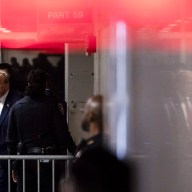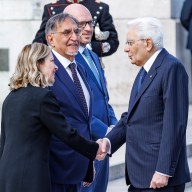 A Russian Navy ship sails to Sevastopol bay on March 7, 2014.
A Russian Navy ship sails to Sevastopol bay on March 7, 2014.
Credit: Getty Images
The growing tension between Ukraine and Russia has drawn the world’s attention to Crimea. It’s also invading our lives online.
In front of a border check point, cars are lining up. A soldier can be seen in a corner of the photo, the sky is overcast and a few fir trees are seen in the background.
“Hundreds of thousands flee from the Ukraine to Russia,” a Russian Twitter user posted.
The re-tweets are flooding in and soon the photo has been shared widely.
But the photo actually shows a border checkpoint between Ukraine and Poland. If you look closely, you can see the town’s name, Shehyni, on the station’s façade. This photo is one of many that have been spread during the early days of the conflict, but have been debunked as fake or taken out of context.
Online activist Martin Löwdin calls this a ”war of information.”
“Yes, it is definitely on. In this case you can clearly see how incredibly social media is used. A lot of propaganda photos circulate. Some are illustrations, but also photos of Ukrainians carrying Russian flags and Russian soldiers being clumsy,” he says.
A recent article by the Associated Press gives support to Löwdin’s observations. According to the story, on Sunday, Russia launched a propaganda campaign directed to its own people with ”vague but threatening news that seemed intended to scare the viewers.”
For example, the purported photo of the Ukraine/Russia border control first appeared on a news broadcast on Russian Channel 1, which referenced Polish troops moving towards the Ukrainian border. In fact , though, it was a regular exercise.
Irish journalist Eoghan mac Suibhne works in Düsseldorf, Germany, for the news website Storyful. He scrutinizes news that circulates on social media and if he can verify it, he passes on to clients like the BBC, the New York Times and Al-Jazeera.
He agrees that there is a “war of information” online.
“Everyone who wants to tell a story always has an agenda. You have to know that if you’re going to work in journalism, and that’s why we always try to trace the material we find to its original source. If we find something that is untrue during that process,it is cause enough to doubt the whole thing,” he says.
“Say for instance that we are sent a YouTube clip,” he continues. “Then we search its URL on Twitter and trace it back to its earliest mention. We try to verify it by looking at the background and compare with Google Streetview, and of course we try to reach the person who has posted the clip.”
Many other journalists follow the same process trying to verify information online. On Reddit, the forum SyrianCivilWar has been writing about Syria for ten months. On Google+, Open Newsroom every day publishes photos and films from news events. On the Russian blog Stopfake.org, pro-Ukrainian journalists point out professional demonstrators who frequently appear in Russian media, as well as photos of “Ukrainian armed extremists” who are, in fact, Russians in disguise.
Mac Suibhne says one mistaken publication can destroy your credibility.
“When I was working on the war in Syria, I was accused of being partial – by both sides – simultaneously. It is probably a sign that you are doing a good job as a journalist,” he says.
















